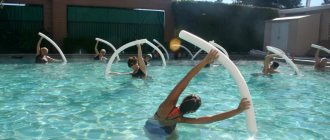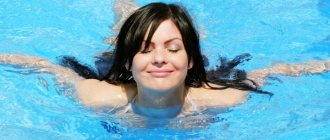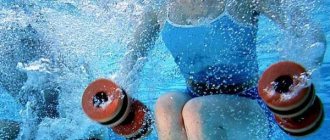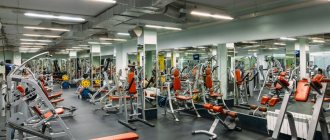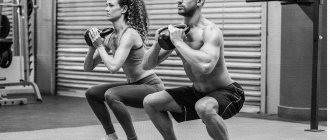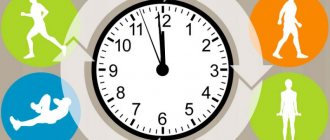Swimming in the pool is one of the most popular and accessible sports. Its advantage is that it is easy to carry out training on your own, without the presence of a trainer. In this article we will look at how to properly train on your own and what benefits swimming brings to the body.
Content
- 1 Swimming: the best training programs
- 2 Terminology of the training process
- 3 Tasks for the warm-up part of the workout 3.1 Series 1. Classic
- 3.2 Episode 2. Liberating
- 3.3 Series 3. Non-standard
- 3.4 Episode 4. Technical
- 3.5 Episode 5. Rhythmic
- 3.6 Episode 6. Smooth
- 4.1 Series 1. Classic
- 5.1 Series 1. Classic
- 6.1 Series 1. Classic
- 7.1 Series 1. Classic
- 8.1 Series 1. Classic
- 9.1 Series 1. Classic
- 10.1 Series 1. Classic
Necessary equipment
Are you determined to lose weight through swimming? Well, this is commendable, but first, go to a sports store and purchase the necessary equipment for exercise.
Simple and very inexpensive equipment will make going to the pool a real holiday, will make you feel like a professional, and most importantly, will also actively participate in the fight against excess weight.
- Glasses
The most important criterion when choosing swimming goggles is tightness, i.e. the ability to keep water out.
- Swimsuit
For active swimming, a woman will need a practical, comfortable swimsuit. It shouldn't rub anywhere and you shouldn't be constantly afraid of losing it. It is better to give preference to a one-piece model, which should match your size.
- cap
There is no need to throw money away buying a swimming cap. In terms of functionality, they are all the same - there is no fundamental difference in the models.
- Slippers
Non-slip soles are the main criterion for choosing slippers in which you will get to the pool.
- Flippers
Perhaps the only sports equipment that somehow contributes to weight loss. After all, swimming with fins increases the load on your legs and makes you lose weight more actively in your waist and sides.
Specifically for training in the pool and exercises in the water, you do not need any specialized equipment. But many people ignore the above things, believing that they do not play any role in losing weight.
And only a few understand that without them, while swimming, there is a risk of contracting an infection, getting conjunctivitis, slipping and getting injured. And all these circumstances will keep you away from classes for a long time, and accordingly, you won’t be able to say goodbye to excess weight either.
On a note. The best time for swimming is 7-9 and 18-20 hours. In the morning, the body is relaxed and very susceptible to this kind of stress. In the evening, this sport can burn maximum calories.
Swimming: the best training programs[edit | edit code]
Lesson scheme
In order to create a training series, select task options from this application. We offer representatives of each of the six categories of swimmers special exercises for different stages of the training process. They include:
- warm-up tasks;
- lead-in tasks;
- tasks for practicing technical skills;
- stimulating tasks (tasks at Critical Swimming Speed (CSS));
- endurance challenges (suitable for triathletes preparing to compete in Ironman races and open water swimmers);
- sprint tasks;
- tasks for practicing skills in open water;
- recovery tasks.
The tasks are combined into series to take into account the individual characteristics of swimmers.
- Classic series (good for Arnie).
- Liberating series (suitable for “bambino”).
- Innovative series (well suited for “drummers”),
- Technical series (suitable for gliders).
- Rhythmic series (well suited for swingists).
- Smooth series (pay attention to “smoothies”).
Choose a task that suits your swimming style and mood, and “mix” it with other tasks, building your own workout. Endurance tasks need to be considered separately, since they themselves are already training series, but from all the other exercises you need to create a full-fledged workout. Usually it consists of several required parts.
- Warm-up part.
- Leading part.
- The main part of the training, for which you can choose series: for technique;
- sprint;
- KSP;
- practicing skills in open water.
You can make over 5000 different combinations!
Pool lesson plan
Schedule
First of all, it should be noted that there is no universal training scheme - it all depends on the individual characteristics, capabilities and goals of each person.
If you come up with an “average” recommended lesson plan for beginners, it might look like this:
- number of workouts: 3 times a week;
- duration: 30-60 minutes;
- what to do: establishing technique, developing endurance, strength and speed qualities (see more below).
Intensity
Attention: prolonged exercise at too high a pulse is harmful to the heart!
We wrote in detail about the negative consequences of acidification of the heart muscle here.
Therefore, you should definitely monitor your heart rate - calculate your maximum allowable heart rate (220 minus your age), and take 50-80% of it and not exceed this level, or also calculate your heart rate using the Karvonen formula (all given in the same article).
Strength exercises
If you want to swim fast and achieve serious results, then in addition to training in the water, training for swimmers on land is also recommended - in order to prepare the corresponding muscle groups involved in swimming.
This video explains it very well:
Terminology of the training process[edit | edit code]
We will use abbreviations in the description of tasks and series. Their list is given below.
| v/s- | coordinated freestyle swimming |
| "include"- | it is assumed that there is a certain distance, broken into two (or more) parts, which should be swam continuously, i.e. 25m defined event / 25m freestyle |
| int.— | you need to swim very intensely, in other words, quickly |
| R- | swimming in a certain mode: for example, P = 1:00 (60 s). This means that you must start each segment one minute (60 seconds) after starting the previous segment, i.e. if the mode was set to a distance of 50 m, which you swim in 45 seconds, then you will have 15 seconds left to rest before the next swim |
| usk. 1-4 — | means acceleration on each of the four segments defined in the task. Swim each subsequent segment faster than the previous one, usually this is done in such a way that the last segment is swam at the threshold speed |
| PV- | timed swimming, i.e. swimming over a certain distance with time control |
| HP- | swimming on hands with a bun. Using a knob held between your legs makes it easier to concentrate on practicing your strokes and/or rotating your body. Place the bun as high as possible in the groin area. In tasks with a kolobashka, you can, if desired, use paddles and ropes |
| Heart rate- | heart rate, pulse, measured in beats per minute |
| flippers- | swimming with fins. This involves the use of fins to perform one or another part of the task. |
| + xx s- | a mandatory rest pause of xx s between each part of the task, regardless of what speed was achieved |
| breathing: 3 degrees / 5g.- | inhale after 3 or 5 strokes |
| KSP- | critical swimming speed, determined in time trials at distances of 400 m and 200 m, see chapter 27 |
| KSP ±8 s — | used in the series to indicate greater or lesser speed than KSP. A distance of 100 m is assumed unless otherwise stated |
| TT- | torpedo push. Pushing off from the wall of the pool, while the body should be in a streamlined position: arms extended forward behind the head |
| 3 x (4 x 100 m) - | three series of four segments, each of which is 100 meters, usually all segments in three series are identical |
| ↑/↓ | swimming two segments (there and back). You swim a distance from one end of the pool to the other, completing the task assigned to you (for example, an exercise), and then return, completing another task (for example, just swimming high-speed) |
| PP- | swimming in a straight line. Continuous freestyle swimming, straight |
| KP- | medley swimming. Combined swimming style in the following sequence: butterfly, backstroke, breaststroke, freestyle |
| Legs on the side (to be specified, on the left or right side) - | kicks are performed on the side, with the chest facing one wall of the pool and the back facing the other. The upper hand should remain on the hip, the lower, leading hand should be stretched forward, the ear pressed to the shoulder of the leading hand |
| Harnesses - | you can use an old inner tube from a motorcycle or car, are designed to pull your ankles together to improve muscle control while working to increase your stroke rate |
Advantages
If you still doubt whether swimming is good for losing weight, the list of its undeniable advantages in this matter will convince you that you can become slim and fit with it. This type of physical activity is highly recommended for overweight women for several reasons:
- swimming is a minor load on the musculoskeletal system, so many kilograms are not a hindrance for this sport;
- water creates a “hydraulic weightlessness” effect, which allows you to perform even the most difficult exercises without feeling tired and without serious stress on the muscles, which is still happening;
- swimming is suitable for weight loss for any category of citizens: teenagers and pensioners, athletes and even the disabled;
- an additional and very pleasant bonus of this method of losing weight is natural hydromassage, which eliminates cellulite and orange peel;
- active burning of calories.
So swimming as a way to lose weight is an excellent option for overweight people who, for some reason, are not suitable for training in the gym or playing another sport.
And yet, not everyone manages to get rid of extra pounds by visiting the pool. The thing is that if you just come to the pool to swim from time to time, without any set of exercises and programs, without the support of a trainer and a proper nutrition plan, nothing will work out. Like any medal, there is a downside - disadvantages.
Interesting fact. If we compare swimmers with other athletes, among them there are 2 times fewer of those who suffer from hypertension.
Tasks for the warm-up part of the workout[edit | edit code]
Simple tasks that gradually increase your heart rate.
Episode 1. Classic[edit | edit code]
Target
: Start your workout in a good mood by doing simple exercises.
Tasks
400 m h/s, easy, follow smooth exhalation and bilateral breathing + 30 s
300m HP with bob, ensure good body rotation + 20s
200 m fins ↑ “Broken Arrow” ↓free v/s + 15 s
100 m a/s, smooth and calm
Full distance
1000 m
Episode 2. Liberating[edit | edit code]
Target
Use fins to move smoothly, without tension, to the main part of the workout.
Tasks
2 times 200 m with long fins, smooth footwork, easy breathing + 20 s
2 x 100 m fins ↑6/1/6 ↓v/s + 15 s
2 x 50 m h/s, easy, relaxed + 10 s
Full distance
700 m
Episode 3. Non-standard[edit | edit code]
Target
The joy of life in all its diversity!
Tasks
3 times
Full distance
900 m
Option 1
- 100 m a/s, easy + 10 s
- 2 x 50 m + 10s HP - good grip
- 4 x 25 m + 5s h/s: odd - fast, even - easy
Option 2
fins, breathing: 5 gr. (v/s)
TT, alternating push-off on the chest with push-off on the back
HP with kolobashka, breathing: 1) 3 g.; 2) 5 g; 3) 7 gr.; 4) 3 gr.
Option 3
V/s, calmly and smoothly
fins: 25 m “Shoulder taps” 125 m h/s
V/s - gradual acceleration
Episode 4. Technical[edit | edit code]
Target
Development of coordination of movements and “sense of water”.
Tasks
5 x 200 m + 20 s
- h/s, breathing: 25 m left + 25 m right + 50 m bilateral
- fins ↑6/3/6 — ↓v/s
- h/s, breathing: 25 m left + 25 m right + 50 m bilateral
- HP: 15 m Rowing No. 1 + 85 m h/s
- v/s - at a relaxed pace, calm and relaxed
Full distance
1000 m
Episode 5. Rhythmic[edit | edit code]
Target
Warm-up for more experienced swimmers.
Tasks
2 x 500 m + 30 s
- in coordination - monitor breathing and smoothness of the stroke; constantly maintain an optimal reasonable pace
- HP - in the first and last 200 m = bun and tourniquet;
average 100 m = harnesses only
Full distance
1000 m
Episode 6. Smooth[edit | edit code]
Target
Learn to monitor the rhythm and coordination of breathing.
Tasks
200 m easy h/s - bilateral breathing
200 m HP - respiration: 5 gr.
200 m fins — ↑25 m Unco left +1 25 m h/s ↓25 m Unco right +25 m h/s
200 m HP - alternate sides for breathing every 25 m
200 m easy h/s - bilateral breathing
Misconceptions of a novice swimmer
Often, beginners do not take initial technical recommendations seriously and do not adhere to rules that were not invented in vain. They ignore advice that it is better to help with the surface of the hands and feet, pushing off and starting to move at a distance. Breathing at the initial stage of training is not yet formed effectively.
Important! A head positioned contrary to the rules and advice interferes with natural breathing and also increases water resistance, and accordingly speed is lost.
Recovery part of training[edit | edit code]
Speed table
Designed to gradually reduce the heart rate and remove metabolic products from the body.
Episode 1. Classic[edit | edit code]
Target
Relieve tension from the muscles of the shoulder girdle.
Tasks
100 m easy v/s
100m fins ↑"Broken Arrow" ↓v/s 100m easy HP, good body rotation
Full distance
300 m
Episode 2. Liberating[edit | edit code]
Target
Falling in love with the water, even stopping at the deep end of the pool every time to dive three times.
Exercise
200 m fins - strokes are long and smooth, watch your exhalation
Full distance
200 m
Episode 3. Non-standard[edit | edit code]
Target
Favorite series! The easiest way to relax!
Exercise
200 m with 2 x 50 m easily in/s
50m backstroke: arms - simultaneously, legs - breaststroke
Episode 4. Technical[edit | edit code]
Target
Try to control your speed while continuing to swim smoothly and consistently.
Exercise
6 x 50 m + 10 s, speed decreases by 2 s every 50 m, at the end very slowly
Full distance
300 m
Episode 5. Rhythmic[edit | edit code]
Target
Gradually reduce the stroke frequency, the movements remain smooth.
Exercise
6 x 50 m + 15 s, stroke rate decreases by 2 G/min every 50 m
Full distance
300 m
Episode 6. Smooth[edit | edit code]
Target
Finish your workout smoothly!
Tasks
100 m easy v/s
100 m HP
100 m high-quality fins
Full distance
300 m
Indications and contraindications
It’s worth starting with the fact that the administration of any swimming pool does not have the right to allow clients into the pool without a medical certificate of health. After all, catching the same fungus in the shower is easier than ever.
Contraindications for which you should not visit the pool are as follows:
- Skin diseases. Fungus, dermatitis, furunculosis, eczema, etc. This also includes the presence of open wounds.
- Heart diseases. In case of arrhythmia, angina pectoris, heart failure and heart disease, exercise in the pool is either completely prohibited or must be supervised by a specialist.
- Chronic diseases. Tuberculosis, pneumonia, bronchitis, asthma (during exacerbation), otitis media, sinusitis, sexually transmitted diseases, epilepsy, oncology, worms, pathologies of internal organs.
- ARVI.
- Eye infections.
It is also highly advisable to visit an allergist before visiting the pool and find out if you are allergic to chlorine.
Indications for exercising in the pool include:
Presence of intervertebral hernias. Swimming is possible strictly under the supervision of a specialist, otherwise the disease can worsen.- Passive lifestyle. Regular exercises help cope with swelling and heaviness in the limbs, and also normalize blood supply to the pelvic organs.
- Stress, sleep problems, lethargy. Swimming has a tonic effect on the nervous system and blood supply to the brain.
- Excess weight. While swimming, calories are burned, and the water itself increases the elasticity and firmness of the skin.
Additionally, swimming has a positive effect on lung capacity, increases bone density, develops flexibility, is suitable for pregnant women and is good for joints. Any positive effect is possible only if the exercises are performed correctly
Recommendations from experts
The benefits and harms of swimming in the pool depend on the attitude of the swimmer himself. If a person has never dealt with water, he must first learn not to be afraid of it, get used to the feeling of water on his face. You can simply lower your head under the water and dive shallowly. It is better if at first there is always a bottom under your feet. To learn how to stay on the surface, start by swimming on your back. Special exercises with a board for beginners are useful.
When swimming, inhale only through the mouth, exhale through the nose. The difficulty is not to take in water as you exhale when diving.
When the water is no longer scary, they start with breaststroke or doggy style. There will be health benefits, but without extreme stress. For fit people who need to keep in shape, the crawl with butterfly “inserts” is recommended.
The main thing is not to quit classes if something doesn’t work out. By training regularly, people quickly notice how swimming affects their figure, tone, well-being and mood. The very quality of life changes, regardless of the level of training or the chosen style.
Beginners are recommended to use special exercises with a board
It is important to master the correct breathing technique: inhale only through the mouth, exhale through the nose
Having learned to confidently float on the water, you should start mastering sport swimming with breaststroke. If necessary, you can use a special simulator
